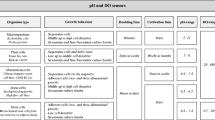Abstract
Optical chemical sensors are the standard for pH monitoring in small-scale bioreactors such as microtiter plates, shaking flasks or other single-use bioreactors. The dynamic pH range of the so far commercially available fluorescent pH sensors applied in small-scale bioreactors is restricted to pH monitoring around neutral pH, although many fermentation processes are performed at pH < 6 on industrial scale. Thus, two new prototype acidic fluorescence pH sensors immobilized in single-use stirred-tank bioreactors, one with excitation at 470 nm and emission at 550 nm (sensor 470/550) and the other with excitation at 505 nm and emission at 600 nm (sensor 505/600), were characterized with respect to dynamic ranges and operational stability in representative fermentation media. Best resolution and dynamic range was observed with pH sensor 505/600 in mineral medium (dynamic range of 3.9 < pH < 7.2). Applying the same pH sensors to complex medium results in a drastic reduction of resolution and dynamic ranges. Yeast extract in complex medium was found to cause background fluorescence at the sensors’ operating wavelength combinations. Optical isolation of the sensor by adding a black colored polymer layer above the sensor spot and fixing an aperture made of adhesive photoresistant foil between the fluorescence reader and the transparent bottom of the polystyrene reactors enabled full re-establishment of the sensor’s characteristics. Reliability and operational stability of sensor 505/600 was shown by online pH monitoring (4.5 < pH < 5.8) of parallel anaerobic batch fermentations of Clostridium acetobutylicum for the production of acetone, butanol and ethanol (ABE) with offline pH measurements with a standard glass electrode as reference.





Similar content being viewed by others
References
Huber R, Ritter D, Hering T, Hillmer A-K, Kensy F, Müller C, Wang L, Büchs J (2009) Robo-Lector—a novel platform for automated high-throughput cultivations in microtiter plates with high information content. Microb Cell Fact 8:42. doi:10.1186/1475-2859-8-42
Hortsch R, Weuster-Botz D (2010) Milliliter-scale stirred tank reactors for the cultivation of microorganisms. In Laskin AI, Sariaslani S and Gadd GM (Eds): Advances in Applied Microbiology, Vol. 73, Elsevier BV, Amsterdam, pp 61–82
Kirk T, Szita N (2012) Oxygen transfer characteristics of miniaturized bioreactor systems. Biotechnol Bioeng 110:1005–1019
Harms P, Kostov Y, Rao G (2002) Bioprocess monitoring. Curr Op Biotechnol 13:124–127
Wencel D, Abel T, McDonagh C (2014) optical chemical pH sensors. Anal Chem 86:15–29
Klimant I, Huber C, Liebsch G, Wolfbeis OS (2001): Dual lifetime referencing (DLR)—a new scheme for converting fluorescence intensity into a frequency-domain or time-domain information. In: Valeur, Bernard und Brochon, Jean-Claude, (eds.) New trends in fluorescence spectroscopy: applications to chemical and life sciences. Springer Series on Fluorescence, 1 (13). Springer, Berlin, 257-274
Liebsch G, Klimant I, Krause C, Wolfbeis OS (2001) Fluorescent imaging of pH with optical sensors using time domain dual lifetime referencing. Anal Chem 73:4354–4363
Arain A, John GT, Krause C, Gerlach J, Wolfbeis OS, Klimant I (2006) Characterization of microtiterplates with integrated optical sensors for oxygen and pH, and their applications to enzyme activity screening, respirometry, and toxicological assays. Sens Actuat B 113:639–648
Walker GM (2000) Yeast physiology and biotechnology. Wiley, West Sussex, pp 144–149
Knorr B, Schlieker H, Hohmann H-P, Weuster-Botz D (2007) Scale-down and parallel operation of the riboflavin production process with Bacillus subtilis. Biochem Eng J 33:263–274
Faust G, Janzen N, Bendig C, Römer L, Kaufmann K, Weuster-Botz D (2014) Feeding strategies enhance high cell density cultivation and protein expression in milliliter-scale bioreactors. Biotechnol J 9:1293–1303
Kusterer A, Krause C, Kaufmann K, Arnold M, Weuster-Botz D (2008) Fully automated single-use stirred-tank bioreactors for parallel microbial cultivations. Bioproc Biosys Eng 31:207–215
Hortsch R, Krispin H, Weuster-Botz D (2011) Process performance of parallel bioreactors for batch cultivation of Streptomyces tendae. Bioproc Biosys Eng 34:297–304
Bendig C, Weuster-Botz D (2013) Reaction engineering analysis of cellulase production with Trichoderma reesei RUT-C30 with intermittent substrate supply. Bioproc Biosys Eng 36:893–900
Riedlberger P, Brüning S, Weuster-Botz D (2013) Characterization of stirrers for screening studies of enzymatic biomass hydrolyses on a milliliter-scale. Bioproc Biosys Eng 36:927–935
Puskeiler R, Kaufmann K, Weuster-Botz D (2005) Development, parallelization and automation of a gas-inducing milliliter-scale bioreactor for high-throughput bioprocess design (HTBD). Biotechnol Bioeng 89:512–523
Weuster-Botz D, Puskeiler R, Kusterer A, Kaufmann K, John G, Arnold M (2005) Methods and milliliter scale devices for high- throughput bioprocess design. Bioproc Biosys Eng 28:109–119
Schmidt M, Weuster-Botz D (2012) Reaction engineering studies of acetone-butanol-ethanol fermentation with Clostridium acetobutylicum. Biotechnol J 7:656–661
Klimant I (2003) Patent US 6,602,716 B1
Monot F, Martin JR, Petitdemange H, Gay R (1982) Acetone and butanol production by Clostridium acetobutylicum in a synthetic medium. Appl Environ Microbiol 44:1318–1324
Korz DJ, Rinas U, Hellmuth K, Sanders EA, Deckwer WD (1995) Simple fed-batch technique for high cell density cultivation of Escherichia coli. J Biotechnol 39:59–65
Acknowledgments
This work was funded by the Bavarian Ministry of Economic Affairs and Media, Energy and Technology and the companies PreSens Precision Sensing GmbH, Regensburg, Germany and 2mag AG, Munich, Germany. Assistance from Michael Geitner and software support by Dirk Hebel (Technische Universität München, Garching, Germany) is gratefully acknowledged. The authors also gratefully acknowledge the support of Nils H. Janzen and Michael Schmidt by the TUM Graduate School at the Technische Universität München, Munich, Germany.
Author information
Authors and Affiliations
Corresponding authors
Rights and permissions
About this article
Cite this article
Janzen, N.H., Schmidt, M., Krause, C. et al. Evaluation of fluorimetric pH sensors for bioprocess monitoring at low pH. Bioprocess Biosyst Eng 38, 1685–1692 (2015). https://doi.org/10.1007/s00449-015-1409-4
Received:
Accepted:
Published:
Issue Date:
DOI: https://doi.org/10.1007/s00449-015-1409-4




